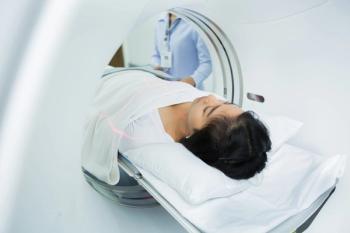
Report from RSNA: Pediatric CT dose reduction drive goes global
This year for the first time the RSNA meeting offered a scientific abstract session dedicated exclusively to pediatric CT and dose. Papers from Asia, Europe, and the U.S. reflect that the growing concern over radiation exposure from medical imaging, particularly in young patients, has reached almost every corner of the world.
This weight-based automatic exposure control CT scan shows the color code with indications for a pediatric patient who has undergone previous imaging exams. (Provided by Dr. Mannudeep Kalra and S. Westra from MGH for Children)
This year for the first time the RSNA meeting offered a scientific abstract session dedicated exclusively to pediatric CT and dose. Papers from Asia, Europe, and the U.S. reflect that the growing concern over radiation exposure from medical imaging, particularly in young patients, has reached almost every corner of the world.
"This is certainly a timely topic. This single session of papers dedicated to dose and dose reduction represents something that was inconceivable five years ago. It also shows there is a global investment in this issue," said Dr. Donald P. Frush, a radiologist at Duke University and one of the moderators of the session. A joint team of investigators from the Medical University of South Carolina and the University of Munich in Germany presented an automatic tube current modulation scanning protocol for children undergoing cardiovascular imaging with 64-slice CT angiography. The protocol included an algorithm to adjust tube voltage settings at 80, 100, and 120 kVp according to the patient's weight. Coauthor Dr. Josef Kerl and colleagues reviewed data from 30 children who underwent CTA with this protocol and correlated findings with available echocardiography, angiography, or surgery data. They found that automatic tube current modulation combined with the weight-based tube voltage settings reduced radiation exposure by almost 60% without affecting image quality.Dr. Sjirk Westra and colleagues from the Massachusetts General Hospital for Children introduced a similar weight-based automatic exposure control CT protocol with a twist. The system flags patients with color codes according to clinical indication and cumulative dose exposure. The investigators reviewed results from 157 pediatric patients and evaluated the technologists' compliance with the color-coded, automatic exposure control scanning protocol. They confirmed more than 90% compliance and dose reductions that ranged from 40% to 70% depending on the color zone in which a patient was allocated.Researchers from China presented results from another automatic exposure control protocol on 40 children undergoing 64-slice CT scans of the chest with tube current settings adjusted to weight and size. The investigators compared this population retrospectively with a matched group of patients who had undergone scanning with fixed tube currents of 120 mAs and 150 mAs for children under one year and older than one year, respectively. They found this protocol provided images of consistent diagnostic quality and significantly reduced radiation dose.Duke University researchers introduced a radiation dose reduction system that simulates nodules and noise in pediatric multislice CT scans of the chest. The technique could help physicians get the proper settings for diagnostically accurate low-dose exams and avoid subjecting children to unnecessary radiation exposure.
Newsletter
Stay at the forefront of radiology with the Diagnostic Imaging newsletter, delivering the latest news, clinical insights, and imaging advancements for today’s radiologists.




























